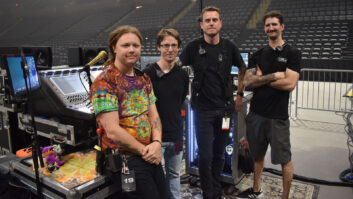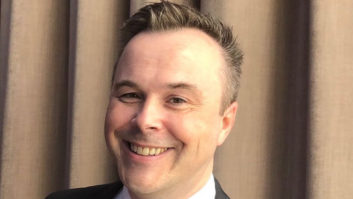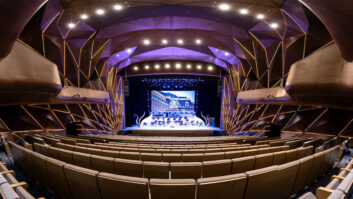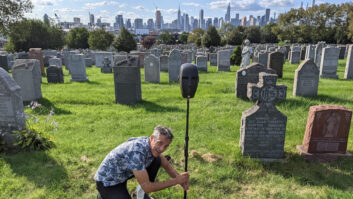Terrence Malick sees and hears the world differently from most people. Perhaps it’s a result of his many years walking and exploring in the natural world, from his home on the plains of Texas. Perhaps it’s a result of his long silent hours indulging his passion, ornithology, where the payoff for hours of solitude is the focused, singular chirp or note, along with a fleeting glimpse, of a rare species. And maybe it’s just that his is a unique approach to filmmaking in today’s exaggerated media landscape.
He’s made only four movies in a 30-plus-year career, and while he doesn’t bring in big box office, he receives almost universal praise from critics. He’s not afraid to hold the camera on a single image way longer than an audience would expect, and he’s not averse to long passages without dialog or music. His approach challenges his audience, and it definitely challenges his collaborators, including the sound crew, many of whom come out of a project saying it was a rare experience and a highlight of their working life, all the while shaking their heads wondering what just went on.
“The number one issue on this film was to have natural sound,” says Skip Lievsay, supervising sound editor and lead re-recording mixer. “[Malick] was really keen on having the sound be a physical part of what coming to a new country, a totally virgin landscape, would be like. He adored the scenery and shot it with no trickery, no plate shots, no CGI. And he wanted the same from sound. It’s such an interesting concept, because the sounds are quite obvious and literal in most cases — the sounds of wind, birds, water, crickets, all grounded in nature, about as fundamental as they could be. But we used them in these very weird and complex constructions, which led to a much more dramatic outcome. For the majority of the movie, we were not allowed to use abstract sounds, and the only reverb we were allowed was to make elements sound authentic to a place. There was no reverb for effect — ever.”
The New World is the Captain John Smith-Pocahontas story, set in Virginia in 1607 and rolling through the first year of settlement in America, and then sailing back to England. Most of the film takes place essentially in two locations, both of which were shot very, very near the original location, which is now a national historic preserve. The authenticity that oozed out of production was carried over into post sound, from backgrounds recorded through the seasons on location to the sounds of the actual armor and weapons crafted for and used in the film. Backgrounds, in fact, became the main element of the soundtrack, functioning as score in many scenes and creating the movement and depth necessary for a two-hour 15-minute movie that is short on dialog.
“[Malick] wanted us to treat backgrounds like they were the music of nature,” says sound effects editor Erik Aadahl. “He used the metaphor of Japanese calligraphy and painting, ‘Just a few strokes, simple but bold.’ He wanted us to make wind through the trees into a character. He played us some CD tracks he loved of nature environments, which he described as ‘more sublime than Beethoven.’”
The core crew, L to R: sound effects editor Erik Aadahl, sound designer/re-recording mixer Craig Berkey, supervising sound editor/re-recording mixer Skip Lievsay, Foley mixer Aaron Glascock, and assistant
Photo: Erik Aadahl
SETTING SAIL
But before going into the backgrounds, it was important for Lievsay and crew to establish a foundation, a tone for the movie. After recording a bit of voice-over in January 2005, and a few locations and effects in March, Lievsay called in sound designer/re-recording mixer Craig Berkey, whom he had first worked with back on Wild, Wild West in 1999. Basic sounds and atmospheres were shipped to the picture editors in Texas, and in return, Lievsay and Berkey received a few edited scenes. Berkey went to work on the battle sequence for reel 5.
“I thought the mix would be fairly simple at that point,” Berkey says. “We had a spotting session, and we found that he wanted to keep it really simple and have depth. We had the movie there ready to watch, and we didn’t look at any of it. We just talked for hours about the concept of the sound: to be oceanic, to be simple, to have depth in the screen.”
“Craig spent a huge amount of time on the battle,” Lievsay says. “We started working on Version 2, which was probably around four hours long, with a much longer battle sequence. We experimented with all types of material and created sort of a baseline, which we brought down to show to Terry, essentially as an audition to try to help him understand how the sound would impact the movie. At the same time, it helped us figure out if we were on the right track.”
After returning with an initial positive response, and anticipating at that point an August final, on Berkey’s recommendation Lievsay brought Aadahl aboard in June. The term “oceanic” was one they were familiar with, from Malick’s work with Paul Huntsman on The Thin Red Line. Japanese calligraphy was another example, then “I want it to sound like a marble on a rolling surface.” Aadahl recalls early terms like “mystery,” “heart opening,” “sense of the infinite,” “sloping” and “on an incline plane.”
“That sounds beautiful,” Berkey says with a laugh. “But then you’re sitting in front of a scene asking, ‘What does that really mean to me?’ You have to interpret it, become a sonic interpreter. Then you learn to trust that when he says something, you can interpret in a way that people respond to positively.”
Craig Berkey at the final, working on effects
Photo: Erik Aadahl
Berkey went back to Marin County, Aadahl back to L.A., and the two started cutting like mad, with Berkey on the battle scenes and middle reels, Aadahl on the beginning and end reels. Berkey began predubbing, nearly simultaneously, in his small room with Pro Tools and a Blue Sky 5.1 monitoring system. As he finished a reel, he would ship the Pro Tools session down to Aadahl, who would conform it, make fixes and send it back. At this point, they figured out a predub layout that carried through to the print master. That simple decision to establish a grid proved to be a lifesaver when changes continually arrived and the versions began piling up. In a word, the premix, and later the final, were elastic.
SIGHTING LAND
It’s important to state at this point that while there was a seeming luxury of time, with the mix being pushed back to November-December, there never was really enough time or money. But Lievsay knew this going in, and because he knew changes would be coming, and because he knew that the film would never really be “finished,” they would edit and mix completely virtual, from the Pro Tools edit to the final mix on a three-position Digidesign ICON console at Warner Bros. Stage 6. No versions were ever printed; nothing was recorded until the print master.
“We went to the dub stage on Version 4 [of the picture edit], and we ended up on Version 10,” Lievsay recalls. “Five versions in five weeks. Very hard work with a crew of basically five at that point. We couldn’t have done it if we’d tried to do it in a conventional way. The only way we could have done it is within this Pro Tools format, where we could make hundreds of changes and conform the mix and not have to go in and patch everything up.”
“The virtual predubs allowed us maximum control and flexibility all the way to the print master,” adds Aadahl. “The downside was that we had to carry massive effects sessions, complete with automation, through version changes all the way through the final. We discovered early on that we couldn’t have done it any other way. Terry would ask us to slip a bird here, nudge a breath there, trim out a bed of insects so they’d start 50 feet earlier. We could do any of these moves instantly, where in the traditional way of working it would have been a significant ordeal.”
Lievsay, background, with supervising music editor Richard Bernstein
Photo: Erik Aadahl
So the final mix turned into a story of backgrounds and movement and depth. This is not a story about dialog. First, there’s very little to talk about, including the voice-over. Second, Lievsay is not at all proud of the dialog track, outside of some of the group ADR, recorded by Michael Haight for both English and Native American (part being a lost Algonquin dialect). It was director’s choice, Lievsay says diplomatically, lamenting the fact that he was not allowed reverb on any of it, including the voice-over. Nor is it a Foley story — there wasn’t enough time or money, though Lievsay’s former company, C5, with Foley walker Marko Costanzo and engineer George Lara, turned in stellar footsteps and props. And finally, it’s not a story of the music, though James Horner and supervising music editor Richard Bernstein delivered a magnificent score. The final was a story of patience, a story of backgrounds, movement, depth and…birds.
ON THE GROUND
Backgrounds and birds essentially became the core of the soundtrack. Much of the raw material was recorded during the spring and summer, at the actual location, by Lievsay’s former partner in New York, Bruce Pross. Aadahl describes the tracks as “exquisite,” while also giving a nod to production sound mixer Jose Garcia, who provided some frogs and insect chatter from Jamestown. Aadahl himself, along with his father, recorded water laps and oar splashes on a canoe outing at Lake Merced in the outskirts of San Francisco. He also picked up some clean wind-through-grass sounds on a quiet day atop Mt. Tamalpais in Marin County. Some of the more whistle-y elements used in the winter storm sequence were recorded using props with air blown over — a colander, a trumpet mouthpiece, a cheese grater. Aadahl says that the tastiest winds came from a vegetable steamer.
At the final, and in fact throughout cutting and predubs, Berkey set up his background groups as wind A, wind B, birds single, birds bed, insects single, insects bed, and water. A feature of the ICON allowed him to then make mix changes instantaneously on the stage. “It’s called custom fader groups,” Berkey explains. “Essentially, you can make any fader or group of faders not change while you’re banking through other faders. Up to this point, in all controllers, when you bank through faders, everything will change. This way, I could keep all my predub masters on a set of faders and they wouldn’t move unless I wanted them to, allowing me to easily bank through only individual elements.”
Besides providing the ultimate in flexibility to accommodate late picture changes, this setup allowed for the creative use of BGs to create movement in the track. “Once we established a nominal sort of location tone, we could constantly weave winds and fade in and out for dramatic effect or just to keep it interesting and lively,” Lievsay says. “Our whole sound palette came down to natural components, and we didn’t want a monotone sound or things that were repeating all the time. So you let one wind come down and another takes over. It can recede and come back later. Terry was adamant that things should just appear, then recede and never be heard again. We did that within reason, but at one point, the movie was two hours and 45 minutes; that’s a lot of film ground to cover.”
The ever-changing winds would then be punctuated with crickets or frogs or, most often, birds. Because Berkey had elements available on the board, he could quickly effect sounds to add depth within the movement. “There are scenes, for example, that might take place onshore with a ship moored out in the harbor,” he says. “So we would take one dry sound in the foreground, one simple sound, and juxtapose that with the appropriate Altiverb sound in the distance. We did that with the birds quite a bit, and the idea is to focus your ear right there. But the sense of depth is lost, we found, if you go too far and try to put a lot of stuff in the distance. Just one-two, and you’re out.”
The other role the backgrounds played was in scene transitions, where Lievsay says they basically broke all the rules and made them up as they went along. “We were not restricted to the picture cuts and scene changes,” Lievsay says. “We let BGs ebb and flow without regard to the physical change. Sometimes, when several scenes were played as one, we would add more complex sounds as we got toward the cut and continue to change the sounds as we got into the new scene. We experimented with every scene change. Sometimes, it worked better to play up the ‘oceanic’ concept. And other times we got into this ‘rude’ idea, which was essentially the hacked together Avid tracks. Oftentimes, we would go from a field to water, so we went for a rude transition.”
The final lasted five weeks, in which time they went through five versions. As soon as they would finish the last reel, they would start all over again. It was a relatively long, drawn-out schedule, which proved misleading for the amount of work and changes. Yes, they were nervous that by never recording even stems, they were risking catastrophe, but Lievsay gives credit to his crew and to Warner Bros. for having extremely tight, foolproof data management. He also gives credit to Malick for fostering a very collaborative environment.
“It was a great long parade of sounds and ideas.” Lievsay concludes. “It was incredibly challenging and very interesting and very difficult work — probably more interesting than anything I’ve worked on in some respects. It was so completely wide open.”
Which is precisely the vision of the explorers as they sailed to The New World.
Tom Kenny is the editor of Mix.
Birds Rule
Director Terrence Malick’s love of birds and bird sounds is well-known, but even he had to wonder, “What would a Carolina Parrot sound like?” This was a difficult question because the species has been extinct since the 1920s. However, in 1607 Virginia, the parrot would have been one of the more colorful and noisy inhabitants of Pocahontas’ world, and it was important to Malick that the sounds of The New World be as historically accurate as the costumes and sets.
Erik Aadahl
Therefore, the production contacted the Macaulay Library at Cornell University’s Lab of Ornithology, which houses the largest collection of animal sounds in the world, with more than 160,000 recordings, including 67% of the world’s birds.
Greg Budney of Cornell took on the challenge of finding a Carolina Parrot stand-in. Although no recordings of the parrot exist, based on body size and beak shape, Budney determined that the Aratinga Parrot song would be a good approximation.
In the end, the Library provided cues for roughly 75 species of birds, frogs, insects and mammals that were appropriate for the story’s time and place. Those sounds were then wrangled by effects editor Erik Aadahl, who says: “In the first hour of meeting Terry, he listed about 20 bird calls that he wanted us to use. One of his best friends is an ornithologist, and he wanted every bird call and frog croak to be accurate for time of day, season and habitat. For the love story, he especially liked antiphonal singers, pairs of birds that sing and respond to each other, like wrens, titmice and cardinals. His favorite call is the hermit thrush.
“I made a spreadsheet organized by the time of day, season and habitat — Lawn & Field, Shrub/Scrub, Upland Forest, Forest Wetland, Emergent Wetland and Wetland Shrub — to make sure no balls were dropped. I then had the complete list of birds fact-checked by the picture department’s resident naturalist, Carey Russell. On the stage, Terry would ask, ‘Hang on, what species is that?’ and we could confidently reply, ‘Oh, that’s a summer tanager.’
“My first week on the film, I bought Dr. Alan Feduccia’s Birds of Colonial Williamsburg to get an idea of species and their habits. I contacted the Los Angeles Natural History Museum’s department of ornithology. Ken Campbell and Kimball Garrett helped with lots of technical questions, like how bird dialects change over time and what species existed in 1607 Virginia but not now. The vocalizations of most ‘non-passerines,’ shorebirds for example, would not change over time, where oscine songbirds might adapt their dialects by meeting other birds of the region. The major difference in birds from then to now is the extinction of the Passenger Pigeon and the Carolina Parrot.
“As a funny aside, Garrett was pleasantly surprised that a movie was striving for such accuracy. He mentioned his frustration when hearing a Tundra-dwelling Willow Ptarmigan calling in the South America jungle scene that opens Raiders of the Lost Ark and the Cactus Wrens of the Southwest appearing in scenes just about everywhere around the world.
“In 2002, the ornithology world was rocked with the rediscovery of a species previously thought extinct: the Ivory-Billed Woodpecker. All scientists had to go on was a dirty recording from Arkansas. There was a lot of debate over whether or not the actual bird had reappeared, and the debate wasn’t settled until August of 2005 when another recording was made and finally confirmed. Terry asked that we put the Ivory-Billed woodpecker strum off in the distance when the film went to end credits as a nod to the birding world.”
All in all, about 100 bird species are represented in the final film.







